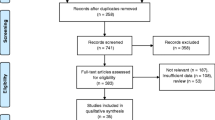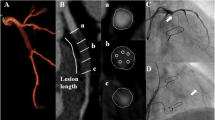Abstract
The aim of this study was to identify predisposing factors for coronary in-stent restenosis (ISR) and assess its detection by 320-row computed tomography angiography (CTA) using invasive coronary angiography (ICA) as a gold standard. A total of 189 patients (aged 35–79, mean age 56.6, 169 males) with 318 stents underwent ICA within 4 days after CTA. ISR was found in 19 (10.0 %) patients and 25 (7.9 %) stents. At the patient level, the presence of ISR was significantly related to the number of deployed stents (P = 0.026) and body mass index (P = 0.030). At the stent level, stents with diameter <3 mm were more likely to have ISR than those with diameter ≥3 mm (53.8 % vs. 28.9 %, P = 0.016). Bare metal stents were significantly more likely to have ISR than drug-eluting stents (15.2 % vs. 6 %, P = 0.022). ISR was not significantly related to stent length (P = 0.097) and stent placement in coronary arteries at the vessel level (P = 0.059). False-positive or false-negative results of CTA were not related to stent location, diameter, length, and strut thickness (P > 0.05). At the patient level, the sensitivity, specificity, positive predictive value, negative predictive value and accuracy of CTA for detecting ISR were 90, 96, 74, 99, and 96 %, respectively. At the stent level, the corresponding figures were 92, 96, 67, 99, and 96 %. The high negative predictive value of 99 % suggests that 320-row CTA is helpful for excluding ISR.







Similar content being viewed by others
References
Go AS, Mozaffarian D, Roger VL, Benjamin EJ, Berry JD, Blaha MJ, Dai S, Ford ES, Fox CS, Franco S, Fullerton HJ, Gillespie C, Hailpern SM, Heit JA, Howard VJ, Huffman MD, Judd SE, Kissela BM, Kittner SJ, Lackland DT, Lichtman JH, Lisabeth LD, Mackey RH, Magid DJ, Marcus GM, Marelli A, Matchar DB, McGuire DK, Mohler ER III, Moy CS, Mussolino ME, Neumar RW, Nichol G, Pandey DK, Paynter NP, Reeves MJ, Sorlie PD, Stein J, Towfighi A, Turan TN, Virani SS, Wong ND, Woo D, Turner MB; American Heart Association Statistics Committee and Stroke Statistics Subcommittee (2014) Executive summary: heart disease and stroke statistics—2014 update: a report from the American Heart Association. Circulation 129(3):399–410
Tsigkas GG, Karantalis V, Hahalis G, Alexopoulos D (2011) Stent restenosis, pathophysiology and treatment options: a 2010 update. Hell J Cardiol 52(2):149–157
Zhang J, Li M, Lu Z, Hang J, Pan J, Sun L (2012) In vivo evaluation of stent patency by 64-slice multidetector CT coronary angiography: shall we do it or not? Int J Cardiovasc Imaging 28(3):651–658
Nakamura K, Funabashi N, Uehara M, Suzuki K, Terao M, Okubo K, Mita Y, Maeda F, Komuro I (2008) Impairment factors for evaluating the patency of drug-eluting stents and bare metal stents in coronary arteries by 64-slice computed tomography versus conventional coronary angiography. Int J Cardiol 130(3):349–356
Hecht HS, Zaric M, Jelnin V, Lubarsky L, Prakash M, Roubin G (2008) Usefulness of 64-detector computed tomographic angiography for diagnosing in-stent restenosis in native coronary arteries. Am J Cardiol 101(6):820–824
Ehara M, Kawai M, Surmely JF, Matsubara T, Terashima M, Tsuchikane E, Kinoshita Y, Ito T, Takeda Y, Nasu K, Tanaka N, Murata A, Fujita H, Sato K, Kodama A, Katoh O, Suzuki T (2007) Diagnostic accuracy of coronary in-stent restenosis using 64-slice computed tomography: comparison with invasive coronary angiography. J Am Coll Cardiol 49(9):951–959
Wykrzykowska JJ, Arbab-Zadeh A, Godoy G, Miller JM, Lin S, Vavere A, Paul N, Niinuma H, Hoe J, Brinker J, Khosa F, Sarwar S, Lima J, Clouse ME (2010) Assessment of in-stent restenosis using 64-MDCT: analysis of the CORE-64 Multicenter International Trial. Am J Roentgenol 194(1):85–92
Chung SH, Kim YJ, Hur J, Lee HJ, Choe KO, Kim TH, Choi BW (2010) Evaluation of coronary artery in-stent restenosis by 64-section computed tomography: factors affecting assessment and accurate diagnosis. J Thorac Imaging 25(1):57–63
Andreini D, Pontone G, Bartorelli AL, Trabattoni D, Mushtaq S, Bertella E, Annoni A, Formenti A, Cortinovis S, Montorsi P, Veglia F, Ballerini G, Pepi M (2009) Comparison of feasibility and diagnostic accuracy of 64-slice multidetector computed tomographic coronary angiography versus invasive coronary angiography versus intravascular ultrasound for evaluation of in-stent restenosis. Am J Cardiol 103(10):1349–1358
Schuijf JD, Pundziute G, Jukema JW, Lamb HJ, Tuinenburg JC, van der Hoeven BL, de Roos A, Reiber JH, van der Wall EE, Schalij MJ, Bax JJ (2007) Evaluation of patients with previous coronary stent implantation with 64-section CT. Radiology 245(2):416–423
Kumbhani DJ, Ingelmo CP, Schoenhagen P, Curtin RJ, Flamm SD, Desai MY (2009) Meta-analysis of diagnostic efficacy of 64-slice computed tomography in the evaluation of coronary in-stent restenosis. Am J Cardiol 103(12):1675–1681
Mercado N, Boersma E, Wijns W, Gersh BJ, Morillo CA, de Valk V, van Es GA, Grobbee DE, Serruys PW (2001) Clinical and quantitative coronary angiographic predictors of coronary restenosis: a comparative analysis from the balloon-to-stent era. J Am Coll Cardiol 38(3):645–652
Rief M, Zimmermann E, Stenzel F, Martus P, Stangl K, Greupner J, Knebel F, Kranz A, Schlattmann P, Laule M, Dewey M (2013) Computed tomography angiography and myocardial computed tomography perfusion in patients with coronary stents: prospective intraindividual comparison with conventional coronary angiography. J Am Coll Cardiol 62(16):1476–1485
de Graaf FR, Schuijf JD, van Velzen JE, Boogers MJ, Kroft LJ, de Roos A, Reiber JH, Sieders A, Spano F, Jukema JW, Schalij MJ, van der Wall EE, Bax JJ (2010) Diagnostic accuracy of 320-row multidetector computed tomography coronary angiography to noninvasively assess in-stent restenosis. Invest Radiol 45(6):331–340
Kakuta K, Dohi K, Yamada T, Yamanaka T, Kawamura M, Nakamori S, Nakajima H, Tanigawa T, Onishi K, Yamada N, Nakamura M, Nobori T, Ito M (2012) Comparison of coronary flow velocity reserve measurement by transthoracic Doppler echocardiography with 320-row multidetector computed tomographic coronary angiography in the detection of in-stent restenosis in the three major coronary arteries. Am J Cardiol 110(1):13–20
Kobayashi M, Asada Y, Matsubara K, Matsunaga Y, Kawaguchi A, Katada K, Toyama H, Koshida K, Suzuki S (2014) Evaluation of organ doses and effective dose according to the ICRP Publication 110 reference male/female phantom and the modified ImPACT CT patient dosimetry. J Appl Clin Med Phys 15(5):4823
Mahnken AH (2012) CT Imaging of coronary stents: past, present, and future. ISRN Cardiol 2012:139823
Dewey M, Zimmermann E, Deissenrieder F, Laule M, Dubel HP, Schlattmann P, Knebel F, Rutsch W, Hamm B (2009) Noninvasive coronary angiography by 320-row computed tomography with lower radiation exposure and maintained diagnostic accuracy: comparison of results with cardiac catheterization in a head-to-head pilot investigation. Circulation 120(10):867–875
Voros S (2009) What are the potential advantages and disadvantages of volumetric CT scanning? J Cardiovasc Comput Tomogr 3(2):67–70
Pasricha SS, Nandurkar D, Seneviratne SK, Cameron JD, Crossett M, Schneider-Kolsky ME, Troupis JM (2009) Image quality of coronary 320-MDCT in patients with atrial fibrillation: initial experience. Am J Roentgenol 193(6):1514–1521
Mori S, Endo M, Nishizawa K, Murase K, Fujiwara H, Tanada S (2006) Comparison of patient doses in 256-slice CT and 16-slice CT scanners. Br J Radiol 79(937):56–61
Steigner ML, Otero HJ, Cai T, Mitsouras D, Nallamshetty L, Whitmore AG, Ersoy H, Levit NA, Di Carli MF, Rybicki FJ (2009) Narrowing the phase window width in prospectively ECG-gated single heart beat 320-detector row coronary CT angiography. Int J Cardiovasc Imaging 25(1):85–90
Carrabba N, Schuijf JD, de Graaf FR, Parodi G, Maffei E, Valenti R, Palumbo A, Weustink AC, Mollet NR, Accetta G, Cademartiri F, Antoniucci D, Bax JJ (2010) Diagnostic accuracy of 64-slice computed tomography coronary angiography for the detection of in-stent restenosis: a meta-analysis. J Nucl Cardiol 17(3):470–478
Sun Z, Almutairi AM (2010) Diagnostic accuracy of 64 multislice CT angiography in the assessment of coronary in-stent restenosis: a meta-analysis. Eur J Radiol 73(2):266–273
Oncel D, Oncel G, Tastan A, Tamci B (2008) Evaluation of coronary stent patency and in-stent restenosis with dual-source CT coronary angiography without heart rate control. Am J Roentgenol 191(1):56–63
Pflederer T, Marwan M, Renz A, Bachmann S, Ropers D, Kuettner A, Anders K, Bamberg F, Daniel WG, Achenbach S (2009) Noninvasive assessment of coronary in-stent restenosis by dual-source computed tomography. Am J Cardiol 103(6):812–817
Zhao L, Zhang Z, Fan Z, Yang L, Du J (2011) Prospective versus retrospective ECG gating for dual source CT of the coronary stent: comparison of image quality, accuracy, and radiation dose. Eur J Radiol 77(3):436–442
Pugliese F, Weustink AC, Van Mieghem C, Alberghina F, Otsuka M, Meijboom WB, van Pelt N, Mollet NR, Cademartiri F, Krestin GP, Hunink MG, de Feyter PJ (2008) Dual source coronary computed tomography angiography for detecting in-stent restenosis. Heart 94(7):848–854
Veselka J, Cadova P, Tomasov P, Theodor A, Zemanek D (2011) Dual-source CT angiography for detection and quantification of in-stent restenosis in the left main coronary artery: comparison with intracoronary ultrasound and coronary angiography. J Invasive Cardiol 23(11):460–464
Zhang XH, Yang L, Wu J, Ju HY, Zhang F, He B, Chen YD (2012) Diagnostic accuracy and its affecting factors of dual-source CT for assessment of coronary stents patency and in-stent restenosis. Chin Med J (Engl) 125(11):1936–1940
Hoffmann R, Mintz GS (2000) Coronary in-stent restenosis—predictors, treatment and prevention. Eur Heart J 21(21):1739–1749
Park SJ, Kang SJ, Virmani R, Nakano M, Ueda Y (2012) In-stent neoatherosclerosis: a final common pathway of late stent failure. J Am Coll Cardiol 59(23):2051–2057
Morice MC, Colombo A, Meier B, Serruys P, Tamburino C, Guagliumi G, Sousa E, Stoll HP; REALITY Trial Investigators (2006) Sirolimus- vs paclitaxel-eluting stents in de novo coronary artery lesions: the REALITY trial: a randomized controlled trial. JAMA 295(8):895–904
Holmes DR Jr, Leon MB, Moses JW, Popma JJ, Cutlip D, Fitzgerald PJ, Brown C, Fischell T, Wong SC, Midei M, Snead D, Kuntz RE (2004) Analysis of 1-year clinical outcomes in the SIRIUS trial: a randomized trial of a sirolimus-eluting stent versus a standard stent in patients at high risk for coronary restenosis. Circulation 109(5):634–640
Shechter G, Resar JR, McVeigh ER (2006) Displacement and velocity of the coronary arteries: cardiac and respiratory motion. IEEE Trans Med Imaging 25(3):369–375
Lim HB, Hur G, Kim SY, Kim YH, Kwon SU, Lee WR, Cha SJ (2008) Coronary stent fracture: detection with 64-section multidetector CT angiography in patients and in vitro. Radiology 249(3):810–819
Pang JH, Kim D, Beohar N, Meyers SN, Lloyd-Jones D, Yaghmai V (2009) Detection of stent fractures: a comparison of 64-slice CT, conventional cine-angiography, and intravascular ultrasonography. Acad Radiol 16(4):412–417
Hecht HS, Polena S, Jelnin V, Jimenez M, Bhatti T, Parikh M, Panagopoulos G, Roubin G (2009) Stent gap by 64-detector computed tomographic angiography relationship to in-stent restenosis, fracture, and overlap failure. J Am Coll Cardiol 54(21):1949–1959
Aoki J, Nakazawa G, Tanabe K, Hoye A, Yamamoto H, Nakayama T, Onuma Y, Higashikuni Y, Otsuki S, Yagishita A, Yachi S, Nakajima H, Hara K (2007) Incidence and clinical impact of coronary stent fracture after sirolimus-eluting stent implantation. Catheter Cardiovasc Interv 69(3):380–386
Nakazawa G, Finn AV, Vorpahl M, Ladich E, Kutys R, Balazs I, Kolodgie FD, Virmani R (2009) Incidence and predictors of drug-eluting stent fracture in human coronary artery a pathologic analysis. J Am Coll Cardiol 54(21):1924–1931
Acknowledgments
The study was supported by a research grant from the Ministry of Science and Technology, Taiwan, with a grant number of 99-2314-B-182-037-MY2 and 103-2314-B-182-012-MY3.
Author information
Authors and Affiliations
Corresponding authors
Ethics declarations
Conflict of interest
All authors assert that there are no conflicts of interest (both personal and institutional) regarding specific financial interests that are relevant to the work conducted or reported in this paper.
Rights and permissions
About this article
Cite this article
Wan, YL., Tsay, PK., Chen, CC. et al. Coronary in-stent restenosis: predisposing clinical and stent-related factors, diagnostic performance and analyses of inaccuracies in 320-row computed tomography angiography. Int J Cardiovasc Imaging 32 (Suppl 1), 105–115 (2016). https://doi.org/10.1007/s10554-016-0872-6
Received:
Accepted:
Published:
Issue Date:
DOI: https://doi.org/10.1007/s10554-016-0872-6




